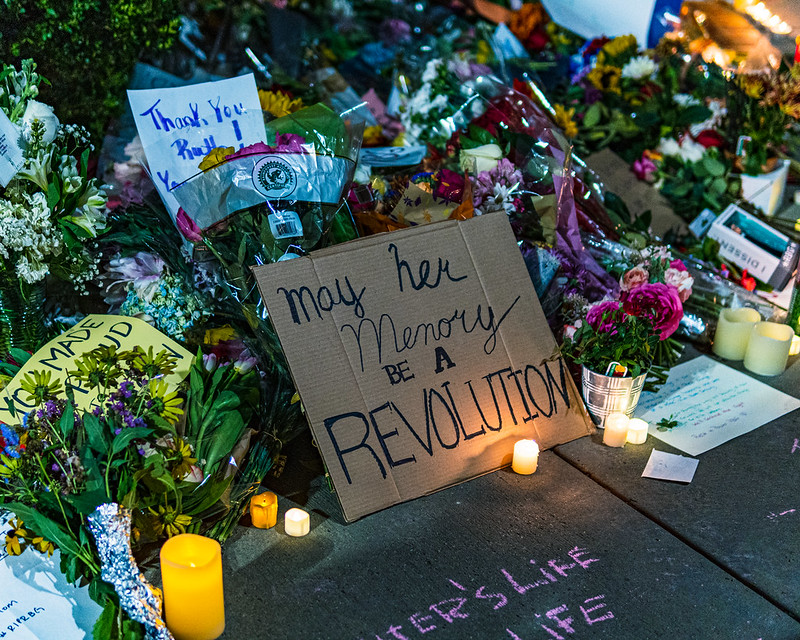Women's Rights & Issues
Related: About this forumAlas, Women--Barrett Is No Ginsburg (In memoriam)
(from 11/2020, prescient)
Alas, Women—Barrett Is No Ginsburg (In memoriam)
11/3/2020 by Genie Harrison
Justice Ruth Bader Ginsburg’s lifelong work to achieve equality was unrelenting while serving on the Supreme Court. On the other hand, Amy Coney Barrett’s appointment to the Supreme Court puts freedom of choice, affordable health care, marriage equality and other hard-won rights are at risk.

Mourning the passing of Ruth Bader Ginsburg, at the U.S. Supreme Court on Sept. 19. (Ted Eytan / Flickr)
A mere month has passed since the death of Ruth Bader Ginsburg, and the Senate has confirmed another woman, Amy Coney Barrett, to fill her spot on the U.S. Supreme Court. The blatant politics and sheer hypocrisy of this fast-track process in the waning days of a presidential election cycle require no further elaboration. What is helpful at this moment in our nation’s history is to examine the character and achievements of these two women, to understand what they have meant and what they will mean—for women, for minorities, for the underprivileged and disenfranchised, for workers and for everyone who cares about the future of our country. Ruth Bader Ginsburg and Amy Coney Barrett share exceptional academic and analytical records. Both graduated at the top of their law school classes and went on to teach law, author papers and achieve recognition as experts in their fields. But that is where the similarities end. It’s instructive to look at these women at the moment of their ascension to the nation’s highest court.
Ruth Bader Ginsburg

Justice Ruth Bader Ginsburg visits Wake Forest University in September 2005. (Wake Forest University / Flickr)
The woman who became known as “the Notorious RBG” married her husband a month after she graduated from her undergraduate studies at Cornell. At the age of 21, she was demoted from her job at the Social Security Administration office in Oklahoma because she became pregnant, and she gave birth to a daughter six months before starting law school at Harvard.She was one of only nine women students in her class. After graduating first in her class from Columbia Law School, where she transferred when her husband obtained a job in New York, she received no job offers and was rejected for a clerkship with then-Supreme Court Justice Felix Frankfurter because of her gender. Ginsburg finally obtained a clerkship with Judge Edmund L. Palmieri of the U.S. District Court for the Southern District of New York. Ginsburg turned these setbacks into opportunities. After her clerkship she was hired as a research associate for and then became the associate director of the Columbia Law School Project on International Procedure. Living in Sweden, she learned Swedish and co-authored a book with Swedish jurist Anders Bruzelius, a project that profoundly influenced her thinking on gender equality.
. . . . .
By the time Ginsburg was named by President Clinton to the Supreme Court in 1993, she had been a federal judge for thirteen years. Justice Ginsburg’s lifelong work to achieve that for which the framers of the Constitution provided—equality—was unrelenting while serving as a Supreme Court Justice. She brilliantly authored opinions, striking down the Virginia Military Institute’s male-only admissions policy as violative of the Equal Protection Clause, and she was famous for her dissents, which she sometimes read from the bench to signal her strong disagreement with the majority.
As her friend, the late Justice Antonin Scalia, aptly said, Ginsburg was the Thurgood Marshall of women’s rights.

. . .
https://msmagazine.com/2020/11/03/women-ruth-bader-ginsburg-amy-coney-barrett/